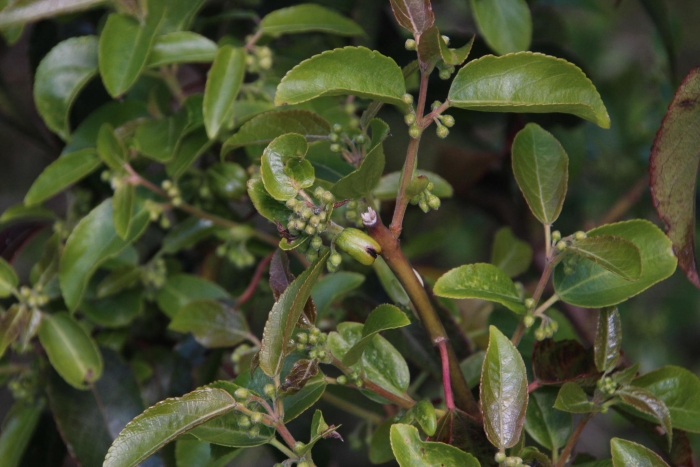Maqui
(Aristotelia chilensis)
Maqui (Aristotelia chilensis)
/
/

Tony Rebelo
CC BY-SA 4.0
Image By:
Tony Rebelo
Recorded By:
Copyright:
CC BY-SA 4.0
Copyright Notice:
Photo by: Tony Rebelo | License Type: CC BY-SA 4.0 | License URL: http://creativecommons.org/licenses/by-sa/4.0/ | Rights Holder: Tony Rebelo | Publisher: iNaturalist | Date Created: 41924 |

























Estimated Native Range
Summary
Aristotelia chilensis, commonly known as Maqui or Chilean Wineberry, is an evergreen tree or large shrub native to the Valdivian temperate rainforests of Chile and the adjacent regions of southern Argentina. It typically grows to a height of 13 to 16 feet (4 to 5 meters) and is characterized by its abundant, flexible branches and oval-lanceolate leaves. The Maqui tree is notable for its small, hermaphroditic white flowers that bloom in late spring, followed by attractive purple-black berries. These berries are rich in anthocyanins and are considered a superfruit due to their high antioxidant content.
The Maqui tree is valued for its ornamental beauty, medicinal properties, and the edible berries it produces, which have a flavor similar to blackberries. It is used in traditional Mapuche medicine and is gaining popularity for its health benefits. In cultivation, Maqui requires well-drained soil, full sun exposure, and is sensitive to frost, making it suitable for USDA zones 8 to 12. While it is drought-tolerant once established, it benefits from regular watering during prolonged dry periods. The tree is relatively low-maintenance but can be susceptible to root rot if overwatered or planted in poorly drained soils. It is not commonly seen in large-scale cultivation outside its native range but is gaining interest for its potential health benefits and as an exotic ornamental plant.CC BY-SA 4.0
The Maqui tree is valued for its ornamental beauty, medicinal properties, and the edible berries it produces, which have a flavor similar to blackberries. It is used in traditional Mapuche medicine and is gaining popularity for its health benefits. In cultivation, Maqui requires well-drained soil, full sun exposure, and is sensitive to frost, making it suitable for USDA zones 8 to 12. While it is drought-tolerant once established, it benefits from regular watering during prolonged dry periods. The tree is relatively low-maintenance but can be susceptible to root rot if overwatered or planted in poorly drained soils. It is not commonly seen in large-scale cultivation outside its native range but is gaining interest for its potential health benefits and as an exotic ornamental plant.CC BY-SA 4.0
Plant Description
- Plant Type: Shrub, Tree
- Height: 10-15 feet
- Width: 8-10 feet
- Growth Rate: Moderate
- Flower Color: Green, White
- Flowering Season: Spring
- Leaf Retention: Evergreen
Growth Requirements
- Sun: Full Sun, Part Shade
- Water: Medium
- Drainage: Medium
Common Uses
Bee Garden, Bird Garden, Edible*Disclaimer: Easyscape's listed plant edibility is for informational use. Always verify the safety and proper identification of any plant before consumption., Low Maintenance
Natural Habitat
Valdivian temperate rainforests of Chile and adjacent regions of southern Argentina
Other Names
Common Names: Maqui Berry, Maqui, Clon, Macqui, Queldrón, Wineberry, Chilean Wineberry
Scientific Names: , Aristotelia chilensis, Aristotelia chilensis, Aristotelia glabra, Aristotelia glandulosa, Aristotelia lucida, Aristotelia macqui, Aristotelia macqui subsp. alpestris, Aristotelia macqui subsp. leucocarpa, Aristotelia macqui var. alpestris
GBIF Accepted Name: